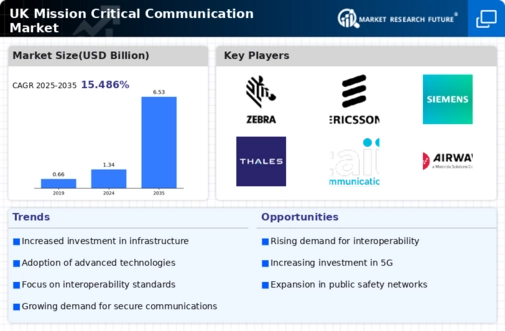Rising Cybersecurity Concerns
Cybersecurity concerns are increasingly impacting the mission critical-communication market, as threats to communication systems become more sophisticated. Organizations are compelled to invest in robust cybersecurity measures to protect sensitive information and ensure the integrity of their communication networks. The UK government has recognized this challenge and is implementing initiatives to bolster cybersecurity in public safety communications. Market analysis suggests that spending on cybersecurity solutions within the mission critical-communication market could rise by 25% over the next few years, as agencies prioritize the protection of their communication infrastructure. This heightened focus on cybersecurity is likely to drive innovation and the adoption of advanced security technologies, shaping the future landscape of the mission critical-communication market.
Regulatory Compliance and Standards
The mission critical communication market in the UK is increasingly influenced by stringent regulatory compliance and standards. Government agencies and organizations are mandated to adhere to specific communication protocols to ensure safety and reliability. The UK government has established frameworks that necessitate the use of secure and resilient communication systems, particularly in emergency services. This regulatory environment drives investments in advanced communication technologies, as organizations seek to meet compliance requirements. The market is projected to grow as entities prioritize adherence to these regulations, which may account for an estimated 20% increase in demand for compliant communication solutions over the next five years. As a result, the mission critical-communication market is likely to see a surge in innovation aimed at meeting these standards.
Growing Focus on Inter-Agency Collaboration
The mission critical-communication market is witnessing a growing emphasis on inter-agency collaboration. As public safety challenges become more complex, agencies are recognizing the necessity of seamless communication across different organizations. This trend is fostering the development of integrated communication platforms that facilitate information sharing and coordination among various entities, including police, fire, and medical services. The market is projected to expand as agencies invest in solutions that enhance collaborative efforts, potentially leading to a 10% increase in market growth over the next few years. This collaborative approach is essential for improving response times and ensuring effective management of emergencies, thereby driving the evolution of the mission critical-communication market.
Increased Demand for Real-Time Communication
The mission critical-communication market is experiencing a notable rise in demand for real-time communication solutions. This trend is largely driven by the need for immediate information exchange in emergency situations, where timely decisions can save lives. Public safety organizations, including police and fire services, are increasingly adopting technologies that facilitate instant communication among teams. The market data indicates that the demand for real-time communication tools is expected to grow by approximately 15% annually, as agencies recognize the importance of swift information dissemination. This shift is prompting investments in advanced communication infrastructure, which is essential for enhancing operational efficiency and effectiveness in critical scenarios. Consequently, the mission critical-communication market is evolving to accommodate these urgent communication needs.
Technological Advancements in Communication Infrastructure
Technological advancements are playing a pivotal role in shaping the mission critical-communication market. Innovations such as 5G networks, artificial intelligence, and cloud computing are enhancing the capabilities of communication systems. These technologies enable faster data transmission, improved connectivity, and greater reliability, which are crucial for mission-critical operations. The UK government has been investing in upgrading communication infrastructure to support these advancements, with an estimated £1 billion allocated for enhancing public safety communication networks. As a result, the mission critical-communication market is likely to witness a transformation, with organizations increasingly adopting cutting-edge technologies to improve their communication capabilities and operational readiness.




















Leave a Comment